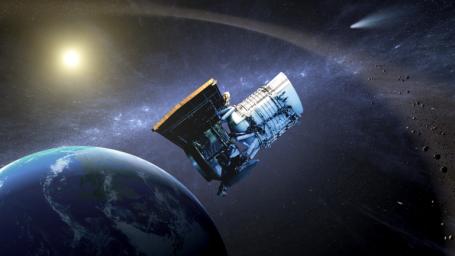
|
NEOWISE: Back to Hunt More Asteroids (Artist Concept)
- Click the image above for a larger view
- Full-Res JPEG (5334 x 3000) (1.7 MB)
- Full-Res TIFF (5334 x 3000) (48.0 MB)
Caption:
This artist's concept shows the Wide-field Infrared Survey Explorer, or WISE spacecraft, in its orbit around Earth. In September of 2013, engineers will attempt to bring the mission out of hibernation to hunt for more asteroids and comets in a project called NEOWISE.
From 2010 to 2011, the WISE mission scanned the sky twice in infrared light not just for asteroids and comets but also stars, galaxies and other objects. Back then, the asteroid-hunting portion of the mission was named NEOWISE, which combines the acronyms for near-Earth objects (NEOs) and WISE. NEOs are those asteroids with orbits that come relatively close to Earth. Now, in its second "lease on life," the mission will be dedicated to asteroid and comet surveying.
Background Info:
JPL manages the Wide-field Infrared Survey Explorer for NASA's Science Mission Directorate, Washington. The principal investigator, Edward Wright, is at UCLA. The mission was competitively selected under NASA's Explorers Program managed by the Goddard Space Flight Center, Greenbelt, Md. The science instrument was built by the Space Dynamics Laboratory, Logan, Utah, and the spacecraft was built by Ball Aerospace & Technologies Corp., Boulder, Colo. Science operations and data processing take place at the Infrared Processing and Analysis Center at the California Institute of Technology in Pasadena. Caltech manages JPL for NASA.
More information is online at http://www.nasa.gov/wise and http://wise.astro.ucla.edu .
For more information on the asteroid initiative, visit http://www.nasa.gov/asteroidinitiative .
Cataloging Keywords:
| Name | Value | Additional Values |
|---|---|---|
| Target | ||
| System | Near Earth Objects | |
| Target Type | Asteroid | |
| Mission | Near-Earth Object Wide-field Infrared Survey Explorer (NEOWISE) | |
| Instrument Host | NEOWISE | |
| Host Type | Space Telescope | |
| Instrument | ||
| Detector | ||
| Extra Keywords | Artwork, Color, Comet, Infrared | |
| Acquisition Date | ||
| Release Date | 2013-08-21 | |
| Date in Caption | ||
| Image Credit | NASA/JPL-Caltech | |
| Source | photojournal.jpl.nasa.gov/catalog/PIA17254 | |
| Identifier | PIA17254 | |
